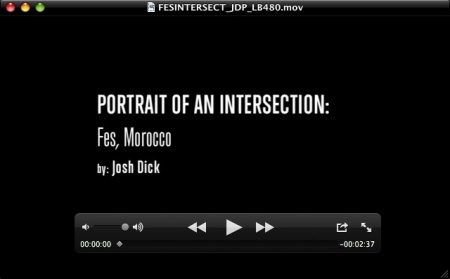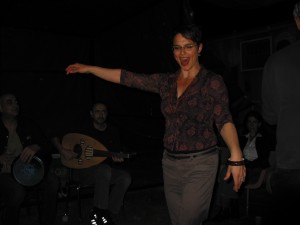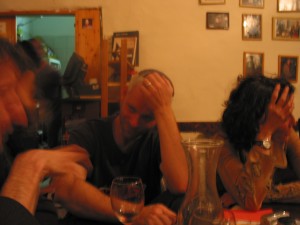The following sequence was shot in the medina of Fes, Morocco, over a period of 74 minutes. The camera was set up on a tripod in a locked position, pointed directly at the cross section of a “T’ intersection. By choosing a simple background and a location off of the main streets in the medina, my goal was to capture the essence of the people inside the medina and strip away the market atmosphere.
Video: “Portrait of an Intersection”, Fes
June 16, 2010Ramallah revisited, courtesy NYTimes
May 22, 2010On our very first evening in Jerusalem (April 19th) a last-minute opportunity presented itself, and so a cab took us across one of the checkpoints to the Ramallah Cultural Palace for an evening of dance like one seldom has a chance to see–a collaborative project between the DC-based City Dance Company and young West Bank dancers (and the concluding evening of the Ramallah International Dance Festival). In today’s NYTimes, Paul Emerson, the company’s director (and, full disclosure, a collaborator with the IWP writers during their 2009 visit to DC, for an evening of City Dance Company’s choreography ‘writing’ their short texts) makes a case for the cultural and political usefulness of such a project. For my part, I mainly remember sitting in the packed auditorium and hoping the forms, shapes, colors and patters of those perfect bodies would go on for hours, encore, ecore.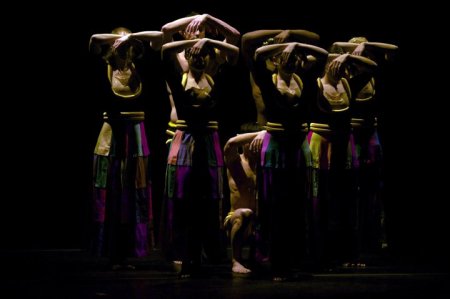
More peacework, and some slaughter
May 18, 2010In Virginia Quarterly Review, Chris writes about his post-Fes travels, back to the West Bank and to Nablus, among the Samaritans.
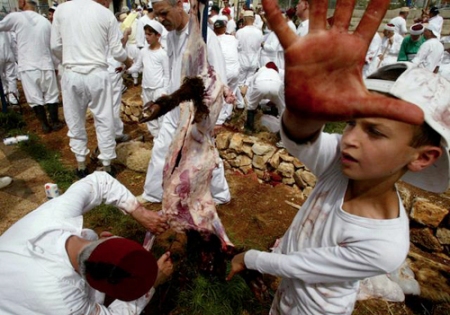
Eddin, preparing to take off
May 10, 2010Eddin Khoo promises
I Will Write of Airports…
Inventories broken in this
Age of the ash apocalypse.
Line upon line of assembled sadness,
A herd homogeneity;
How to survive this?
Imagine a time, as
Eternal as the time before The Fall,
Of unyielding skies, of sterns
Striking at the horizon. Summon
The scent of the sea!
Kuala Lumpur-Doha-Casablanca
Ognjen writes:
May 7, 2010I
H1N1
I missed two days of my stay in Jerusalem, along with a visit to Ramallah and a barbeque with Palestinian artist colleagues. Volcanic ash from Iceland is to blame. I believe that volcanic ash from Iceland contain traces of swine flu as well as the hair from Yeti’s fur. Something called Eyjafjallajokull cannot simply pour out plain dull ash and particles of volcanic glass. As if it weren’t enough, Eyjafjallajokull is exactly 1.666 meters high. The Number of the Beast! Do not try to stop planes with something exactly 1.666 meters high and named Eyjafjallajokull ! All traffic on land should be stopped as well, visits to Jim Morrison’s grave should be prohibited and three or four nuclear bombs dropped on Eyjafjallajokull as a measure of precaution. Alternative solution: Chuck Norris should be invited to piss into the crater. I cannot be the only one to have a solid opinion on this matter. Is there a man on this planet who has suffered H1N1, whose flights have been delayed due to the eruption of an Eyjafjallajokull and who has seen the Yeti? If so, I would love to meet him. (21st April 2010.)
II
O CAPTAIN, MY CAPTAIN!
The taxi driver who took me from the Ben Gurion airport to the American Colony Hotel in Jerusalem knew everything about the world and the cosmos we belong to. He had the stance of a street erudite, and didn’t hesitate to talk every step of the way about genesis, molecular biology, climate change and the art of seduction. He talked incessantly and a lot, burying the small car under piles of words. “Where are you from, my friend?” he asked. “Montenegro” I answered. “Well, of course! Hasta siempre comandante! Ecuador, Columbia, Venezuela, Montenegro!” he said . “I’ve been there!”, he said “You live in the most beautiful country in the world! And your women…! You are a lucky man!” he continued. “Thank you! You are right!” I said, deciding this time to not be proclaiming my Mediterranean pride. When I asked when he visited Montenegro he explained that he toured “the most beautiful country in the world” in 1979, while sailing on a British merchant ship named Aurora. I asked him what specifically he was he doing on the ship and he spoke proudly, self-confidently and quietly: “I was the captain”. (21st April 2010)
III
LET’S FORGET
On my return from Casablanca I spent three hours at Istanbul’s airport, drinking the good and expensive Efes beer. A boy in the national costume was selling ice cream. A lady from England was explaining how she should have gotten more ice cream for her 4 Euros. Waving her hands, she kept pointing her finger at the white cream, folded in abundantly decorated circles. As she was passionately explaining how much she appreciates her money, the boy persisted in pointing at the notice board, repeating one sentence: ‘Your last call madam!” Four Euros and an ice cream were enough for the lady in Adidas sneakers to forget reality. I thought that I wouldn’t be sorry if she missed her flight, and moved on. A group of yellow hats overwhelmed the airport hall, holding British flags in their hands smiling dissent enough of any stupidity. The guide’s hat was the biggest and the yellowest. The ugliest. The writing on their hats said: Let’s forget. Oblivion as an assignment and a desirable state. I wondered what it was they wanted to forget, and I wondered where they are going to forget what it is they were wanting to forget. “Where are you traveling to, madame?” and beneath a brink of her yellow hat the mouth spoke: “Jerusalem, Palestine, Ramallah”. I imagined an ad in the Sunday Times: Come visit where blood shedding conflict happens! Forget the stress of your work place, the subway jams, your pet’s indigestion! I wished the ice cream would be 400 Euros. (24 th April 2010)
IV
AZDI AND ICE
Azdi works for 250 Euros a month. Azdi is the guardian angel of my four room/five star/beautiful roof terrace hotel. Azdi’s three-year old daughter’s name is Mersiha, Azdie’s young wife is Farah. The hotel is located in the heart of the Fes medina, and is their only home as well as their job. Three hundred sixty five days, twenty four hours a day. While beautiful black-eyed Mersiha sits at the door step, Azdi and Farah manage the jobs necessary to make guests feel at home. Toilet cleaners, handymen, breakfast makers, polishers of beautiful ceramics, bag carriers, stealthy walkers-along of the half-business smile. They sleep in a small room in the attic. Azdi says that the French owner comes once in three months, looks around, yells a bit, signs some papers and disappears.
At the Istanbul airport I bought a bottle of my favorite whiskey Cutty Shark. Somebody had misinformed me that alcohol is unavailable in Morocco and I believed him. Some time later, the fine local reds convinced me I was wrong. As I sat on the roof terrace with my Slovenian friend and photographer Jaka, I decided to ask for some ice. Azdi was happy he could please me. He took a nicely decorated metal bowl and led me to a dark room at the first floor. A neon-lit bowl saw his pleased smile. He slipped on a rubber glove and slowly pushed his hand into bowels of a Sharp refrigerator. He acted like surgeon, carefully and with passion. I was expecting a handful of diamonds. However he pulled out ice and then, while it was smoking under the neon light, he said passionately, kissing the tips of his fingers: c’est bon! c’est du bon glace! He said it as it was the finest wine, the loveliest treat, some rare spice. Little Mersiha and Farah stood at the door. I asked them to come closer. Mersiha walked over, reached for the ice cube from her father’s hand and put it delightedly in her mouth. She mingled that coldness, smiling, with her parents. I thought: “Many years later, as he faced the firing squad, Colonel Aureliano Buendía was to remember that distant afternoon when his father brought him along to discover ice.” I also couldn’t help but think how wrong our dear Tolstoy was. He should have said, „All unhappy families are alike; every happy family is happy in its own way”. (25th April 2010)
V
APOLO 11
It always feels good to think that there is a person on the other side of planet reading, for example, Hugo von Hofmannsthal, at the same time as I do. On my way to Casablanca, after I mentioned that brilliant Austrian, my Malaysian friend Eddin placed Hugo’s photograph in the New York Times Book Review in front of my face. I believe we were the first people ever, on the planet Earth, to stare at Hugo von Hofmannsthal’s photo on the road between Fes and Casablanca. (26th April 2010)
some moments in Jerusalem . . .
May 7, 2010From James Fenton’s poem “Jerusalem”
Who packed your bag?
I packed my bag.
Where was your uncle’s mother’s sister born?
Have you ever met an Arab?
Yes I am a scarab.
I am a worm. I am a thing of scorn.
I cry Impure from street to street
And see my degradation in the eyes I meet . . . .
You are in error.
This is terror.
This is your banishment. This land is mine.
This is what you earn.
This is the Law of No Return.
This is the sour dough, this the sweet wine.
This is my history, this my race
And this unhappy man threw acid in my face.
Stone cries to stone
Heart to heart, heart to stone.
These are the warrior archaeologists.
This is us and that is them.
This is Jerusalem.
These are the dying men with tattooed wrists.
Do this and I’ll destroy your home.
I have destroyed your home. You have destroyed my home
href=”https://uipeacework.files.wordpress.com/2010/05/101-0150_img.jpg”>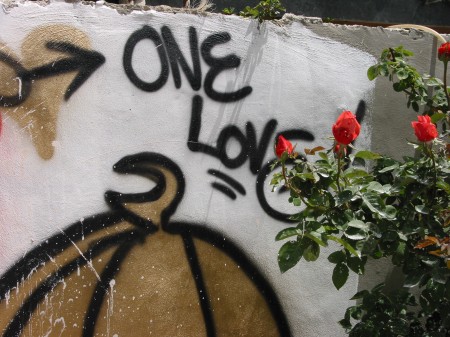 [/caption]
[/caption]
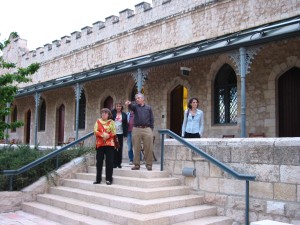
Another way of thinking about Jerusalem; Uri Dromi, and us, at the Mishkenot writers and culture centre . . .
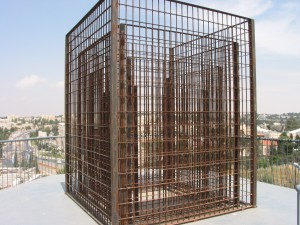
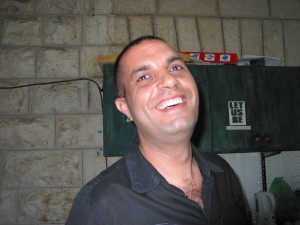
Our Ognen and Israeli poet Shai Dotan being thoughtful and literary in the accepted/recognizable/cross border gesture . . .
LET’S PRETEND THAT THE WAR
by Shai Dotan (seen above w/ Ognen)
“Love I sing, I say love”
Meir Wieseltier
Let’s pretend that the war here was made of love
An oppressed enemy swept away by love
A mutual, one-sided occupation of love
Bustling settlements swarming with love
The eyes of preachers in mosques bellowing love
In refugee camps, walls stained with slogans of love
The news every hour, sugared announcements dripping love
Roadblocks with barbed wires in the name of love
Terrorists infiltrating shopping malls buckled with love
Coexistence, a hollow word, an abandoned tank made of love.
THE SENSE OF THINGS (Part 2)
May 5, 2010Nukila’s post:
The Man Behind The Spectacles
Third meeting with Ibrahim Tijani. We drove off to the sufi village. A simple lunch. My most memorable meal (which deserves another posting for the event itself). We were sitting down on the rugs spread under an olive tree, Ibrahim Tijani sat leaning upon the tree and took off his glasses. Some remarks followed this gesture. He was looking very relaxed and happy to be there. Then Jaka asked Ibrahim for a photograph, he said sure, and Jaka moved the glasses a little further in front of Ibrahim. I suppose he didn’t see this coming. He sat there rather awkwardly in this pose, his glasses on the foreground, as Jaka took the pictures.
This mini-event I found particularly interesting, highly relevant, yet would easily pass unnoticed except from its winning a few remarks that the guy is weird –Jaka, that is, not Ibrahim. I watched Jaka at work in those brief seconds: perhaps there was a parallel feeling towards things, another variation on the same theme, in his way of seeing the ‘thinginess’ of a thing. Glasses are not glasses are not glasses. The glasses just laid there upon the rug. No longer an attribute of the ultimate identity of its owner –the public personage, ultra-person, of this sufi leader. (It was the black robe and the glasses that I first noticed on my first encounter with him at the festival.) And now without the glasses, the man was just being himself, there and then. A regular man, a private self. Telling us personal stories, smelling the red and yellow flowers his daughter picked on the hill.
The man behind the spectacles. Literal and symbolic at the same time in Jaka’s eyes. But again, perhaps… Jaka may have an entirely different take on this. I don’t know.
And let us hope that he will post the photograph.
Unidentified Lying Object
A Berber Market at a village in Essaouira. One of the first stalls near the entrance. I looked at its front part; there was something lying at the counter. Something square-ish, dark red, bits of white, moist, helpless, alone. In a naturalness that was so unassuming. Nearby there were two old men exchanging kisses, and another man, half-hidden behind the counter. This configuration didn’t quite come to me as a common sight in relation to the x thing. That something is hmm something, is… ah, meat. It was only when I saw a huge chunk of leg/shank hanging down near the men’s heads, that the meat-concept came to mind and I finally made sense of the thing. Of course, it’s meat! Zooming out, there were other things: buyers, sellers, bills, transactions, things in their utilized-to-be destiny. Perhaps, in those few seconds there were momentary lapses in a neural circuit somewhere in my brain; some electrochemical signals crossed and got lost –and this created that particular appearance of the meat. Present in its strangeness, a thing-in-itself, bare, unsymbolized, an it. A jamais vu, perhaps. When awareness hangs suspended, untampered by knowledge. A rare moment for me. Too bad, I wouldn’t mind experiencing it on a daily basis.
Afterwards, there came other lying/hanging objects in strange forms. But they came easily identified: animal innards I can’t name, as if created from sweet memories of towels, cylinders, spiral shells etc. Did I feel a relief that my brain was again in its normal modes of operations? Concepts, interpretations, associations –all kinds of references, constructs of thinking, were again there. And with the screams of a goat being slaughtered filling the air, drops and little pools of blood on the ground, I could no longer look at things in their suchness. The rest was a faint familiar feeling of walking around the traditional market at home, yet unfamiliar at the same time.
I Wonder If
travel is one the paths that could provide us with a ‘suchness moment’, to see things as they are. A fresh gaze, like those of saints or children. Traveling would be a shortcut, perhaps, compared to years and years of unlearning and emptying process and disciplines that masters do. Is that why the Monk Kengei, Ibn Arabi, Basho, wandered endlessly from place to place? Perhaps they weren’t looking for answers but questions, and more questions, from within and without, being surrounded by wonders of an unfamiliar world. Perhaps, to wander is to wonder, really.
What Sense Could There Be in Things? …and still, maybe even they didn’t know the sense of things when they saw it.
THE SENSE OF THINGS (Part 1)
May 5, 2010Nukila AMAL’s post:
Variations on a theme. A few different takes on a few things from Essaouira and Fes, in random order –if not chaotic.
A Repertoire of Moroccan Bestiary
Dead, alive, or halfdead-halfalive animals. At the Berber market. Goats, chicken, donkeys. A limp snake – possibly on strike to demand better work conditions, perhaps down with a nasty cold, or simply charmed no more by the young snake charmer. Sardines, pink eels(?), baby shark at the fish market in Essaouira. A postcard of goats on the Argan tree. A little tiny white worm wriggling near a yellow cheese chunk on the table (and the great kingdom of Bacteria at the cheese cottage-factory). A roasted crab looking pretty on my dinner plate at a French-Moroccan restaurant. Head of a dead camel sprouting mint leaves from its mouth, grinning and hanging in front of a meat stall in the Medina, Fes –one could literally brush shoulder with it. More below on the poetics of juxtaposition of things.
Goats on the Argan Tree
I’ve seen real goats (and ate them), I’ve seen real Argan Trees (and bought a few products at the Cooperative Feminine). I had heard story from Zeyba about goats climbing up the Argan tree to eat the fruits. But to see the combination of both things visually, was something else.
At the herbalist shop in Fes. Hundreds of jars and bottles containing candy-colored liquids. We sat in this asymmetrical circle listening to the owner explaining some of the bottles. At times he would pass around small bottles when explaining a certain kind of herb, followed by a dab of scent on our wrists, or a whiff from small bottles… and then came the “>postcard. I looked at it for a few seconds. There they were, eight or nine goats, standing (or perching?) four-legged on the branches of a big Argan tree. A clear blue sky on the background. A couple of the goats stared straight at the camera in such perfect poise, almost like posing. It was beautiful, yet mind-boggling (to my poor mind only, sadly), so surreal it seemed. I blurted out in a wow moment, ‘Are those real goats on the Argan tree?’ (Yes, Chris and Eddin, Argan tree might as well bear goats as its fruit, goats could naturally come with a tree –in a parallel universe). And being a postcard, the photo had all the graphic qualities par excellence; symmetry, colors, expressions (some of the goats were photogenic and quite cool). Perhaps it was this too-beautiful image that led me to the ontological problem of goats. For some weird moments, those goats did look like a bigger version of Christmas tree decorations that come with little strings –bells, socks, candles, angels, etc. Fake goats with little strings strewn on the branches. Or better, one-dimensional, like paper-cut tinsel.
I imagine it would have been entirely different if I saw the goats up a tree directly in front of me. A ‘second-hand’ image of a thing versus direct experience of the thing with the five senses. The smell, the bleatings, movements, the rustles of Argan leaves, the wind on my face, etc… Now, this would be real.
God in Orange Juice
Second meeting with Ibrahim Tijani. We sat at the terrace restaurant at the hotel and talked until midday. The topics roamed from Islam, Sufism, the Tijaniyya tariqa, to the geometry of tiles, the number zero, Darwinian Evolution Theory, etc. Answering our questions patiently in a soft-spoken way, at one point he explained one of the basic tenets of the tariqa, the concept of Immanence. I understood it as an Islamic Neo-platonism concept which traced back from Ibn Arabi’s wahd al-wujud (Unity of Being). Ibrahim Tijani was telling us about the mindset of seeing God in everything everywhere, and after gesturing to our surrounding he pointed towards the white cup in front of him and said, “Even in this. I see God in this orange juice.” I glanced at his cup of orange juice. Earlier at breakfast I’d had the same orange juice, of course in a more secular mood –and guiltily, with an almost Fourierian pleasure. I took a better look at the thing: a white regular cup, regular orange juice (see Jaka Babnik’s photograph series below and check out the cup!). Then I glanced up to the man. I looked at his spectacled eyes, and thought, I would gladly trade those eyes with mine for say, an hour or two, to see things as he saw them. I listened to him speaking, and faintly recalled a verse from a sura in the Quran, ‘Whichever way you turn, there is the face of God’ and uttered it to him afterwards. He nodded and smiled. A beautiful verse. A beautiful concept of seeing things, of looking right through the ‘sense’ of things. You wouldn’t destroy or hurt a thing, and go about humbly.
Profile: Aziz Bousfiha, Desert Mystic or Global Pragmatic?
May 5, 2010Gary Nabhan’s post:
He looked so unassuming, dressing so casually—Western suburban and very cosmopolitan— as we entered his family’s mansion on the outskirts of the New City of Fez. If you happened to sit next to Aziz Bousfiha on a bus or plane, you might not remember what he looked like even a few hours later, for he was rather non-descript…except for a certain unmistakable intensity in his eyes…
His garden was on the way to the airport, someone had told us, but he had a larger farm that he is restoring on the semi-arid ridges beyond the city’s edge. As we looked at his family’s stunning house and the mix of ornamental succulents and cacti edging the paved walkway between the highway and the front door, I felt as though I could be in San Diego, California, Todos Santos, Baja California, Las Vegas, Nevada, or Granada, Andalusia— this was the aggregate of Mediterranean scrub and Mexican desert plants now used in “xeriscaping” all around the world.
Of course, we were between the Mediterranean and the Sahara, so they were not merely surviving but they were thriving. And next to them, a small, slightly-graying modest man on crutches welcomed us:
“Malhaba! Ahlan wa-sahlan!” Greetings, he offered. Welcome, he added as he bowed slightly, grinning from ear to ear. Despite a terrible fall the week before that left him with a herniated disk, this Aziz appeared to be a happy, gracious man.
Six of us followed him inside, where his sister had selected tiles and mosaics to decorate their parents’ home with the utmost of elegance and simplicity. Aziz bade us sit down so that his family could offer us mint tea, coffee and cookies. One of us began to ask about the house and the gardens that surrounded it, but Aziz deflected the questions.
“This is my father’s garden, much of it for beauty, what do you say? For show. I mean, I like it, I have some of my lavender plants here as well as a garden of many fruits and vegetables, but my mind and heart reside in a secret place on the edges of this valley, where ridges conceal it until you are nearly there. I have lived here many years, but even myself, I did not know of the existence of this place until someone took me there….it is a true oasis, one that I have begun to care for, one that needs some repair, but it has hundreds of ancient olives trees that are calling me….”
One of asked if we had time to go there with him, and Aziz shook his head, but appeared not to be frustrated that we had so little time that we could not make it to the secret spot where his querencia– his longing to fuse his very identity with a singular place, resides. And so we tried to learn more about his family, the fashion of their lives, the architecture of their villa, the history of its landscaping, but Aziz with not with us. His soul had already begun to fly over toward that hidden oasis:
“Forgive me, but I must tell someone—I must tell you—of my vision for that place and for many places that are perhaps like it. The idea is to go somewhere in the desert, perhaps to a place that has been neglected or degraded over the years…We’ll proclaim that yes, this has become a desert [i.e., desertified] , but now we’re going to make it into a living oasis, one where we’ll not only respect but where we will nurture a diversity of life. In fact, we’ll arrest all activities or uses of chemicals that damage or kill other species, you know, that reduce diversity. If pesticides might kill off any animals—eliminating them from the landscape—then we’ll eliminate their use.”
One of the crutches fell down to the floor from where it had been propped against his chair, for he had begun to wildly gesture, although their was no stridency in his voice, no obvious eager or promotional flair that made us feel as though he were marketing his vision to us. He simply laid it out, as if it were right there before us in the room, and he was merely describing that which had begun to materialize before our own eyes as well. (Perhaps that is a flaw of each and every visionary, for he does not immediately notice that others cannot not see as fully and richly the vision he is describing, and the skeptics may doubt that it can even exist…) But politeness, skepticism or reservation does not stop a visionary like Aziz from continuing, for what he sees is not a desert mirage, but something palpable:
“Of course, we don’t want to stop with remaking just one oasis….” Aziz now shifted from the singular to the plural, although the rest of us were ignorant about whom the we included:
“Our idea is to bring many, many small farms restored to oasis-like conditions into a chain—how do you say it?— a corridor …. to bring them together into solidarity. It is not that we merely want each oasis farm to become fully self-sufficient, for we want to create oases in solidarity with one another. All will exchange not only goods but ideas with one another, in order to serve the larger community of which they are part. They will also be in exchange with the people of the city who might not be able to grow their own food, but who have arts and ideas they may crave. They may give a portion of their production to these urban dwellers who will become cultural ambassadors for them and for the oasis corridor as whole…”
“And so we will create solidarity among people on and off the farms, who will begin to walk the long road of ancient wisdom again together. We will bring back the old grains of the region—what do you say, seeds? —as symbols of the grains of wisdom we must sow. Over the centuries, these ancient seeds have been adapted to place…”
I could not be sure whether he was speaking of crop seeds or of cultural wisdom at this point….
“Over the centuries, these ancient seeds have adapted not just to a ntural ecosystem, but to a cultural, spiritual setting as well. It is not just about farming plants in a desert oasis…it is about cultivating solidarity among peoples as well…if we get that right, a thousand other things will emerge, flower and bear fruit…”
“But we must return to the adapted seeds, for they play multiple roles, whereas modern hybrid seeds play only one or a few limited roles. When we manipulate seeds to give more yield in quantity, I see only one sad goal driving the entire system: profit. And what one can get out of those genetically-manipulated seeds is just that one thing, at the expense of all other values. In essence, if we take this perilous short cut rather than staying on the long road, we lose all other options.”
Aziz took a brief sip of tea, then plowed on:
“To counter these trends, we must remember that centuries of love and care are manifested in each kind of little seed. There is love and care imbedded in each and every olive growing on our trees, in each grain ground into our bread.”
“And so we must regenerate a series of diverse desert oases, and then link them through our solidarity. Thast solidarity—not any one place in and of itself— makes the cohesiveness, the base that keeps all this diversity intact. Each place, each oasis, is important. And so, no single placer is more important than any of the others. We have to be more than just brothers, each going about our own work. We must work and pray as members of the same community.”
Aziz grabbed his crutches and stood up. He looked at us—spellbound visitors—and laughed.
“You know, it’s funny, but I can’t waste time worrying about whether or not this will work. There is a proverb in Arabic, and I suppose similar ones in other languages. It says it all: If it looks like the last day of the world is upon us, that the end of life may be coming, and you happen to find yourself planting trees that day, well, DON’T STOP PLANTING…”
“It’s not just activism I am talking about, though we may need some of that. I’m talking about something larger, deeper—participating in creation— for that very act is an expression of our love. Yes, love is the driving force. I can say that…Love, why not? “
“Every day, I go out to prune and to renew the growth of a thousand ancient olive trees on that patch of land that was suddenly and mysteriously gifted to me, I know one thing: I must take care of them with love, not just with the science of pruning.”
And with that, Aziz waved us to follow him, and despite his herniated disc and two crutches, he ambled out into the garden, to show us dozens and dozens of kinds of plants he cares for as his life work.
Jujubes, loquats, limes and sweet lemons.
Kumquats, grapefruits, mulberries and olives.
Pomegranites, roses, lavenders, and prickly pears.
Agaves, cardon cactus, safflowers and crocuses.
Scallions, onions, leeks and garlic.
Beets, radishes, spinach and coriander.
Spearmint, peppermint, epazote and sage.
Oregano, sage, rosemary, and thyme.
Sunflower, tomoato, squash and maize.
Common beans, fava beans, chile peppers and cabbage.
Planted in solidarity. More than just companions. Community.
Building in Fez
May 5, 2010Building in Fez
At the beginning of the evening we passed through the parking lot and saw the ambulance and a fire truck, men dressed in the heavy uniforms of disaster, and we wondered collectively and out loud what was going on, smelled for smoke, caught nothing but the usual in the air, dust and animal (cat spray, piles of dead wool rotting beyond the cars), garbage, rain too—it had rained sporadically through the afternoon. Damp dust, no fire. We kept going, according to the schedule, which has been hard to keep, cat-herding to a clock is even harder, all these people and tours and meetings, visits here and there in a labyrinth designed against speedy conclusions. Builders and citizens of old Fez: did you have a deadline in mind? In what century did that deadline fall? Dead line: I think of all long threads of string being used, sort of plumb lines in vertical, by the (suspiciously) young men who are (seem to be) planning the rebuilding of the medina’s interior walls.
Through which we wandered up, up, up, past the babouche slippers and the small pretty drums hanging from wires, (further back in the rectangle of the shop, look at all the instruments hanging on the walls!) through the eternal gate created by black chickens standing on their crates, then meat, represented charismatically by a camel head whose mouth is stuffed with parsley, or an enormous bouquet of sheeps’heads too. Or was the meat before the chicken?–I thought of Eddin and his love for the roast bird–then we were walking between stalls of dates and great loops of dried figs tied on greasy wool string (I ate figs every day for a week after everyone left . . .) and heaps of apricots and raisins, then vegetables, apples and orange-juice stalls, the usual, though the eggplant and the courgettes looked small, tired, more than ready to be eaten.
We were talking—we are always talking, a group of writers giddy with thoughts and opinions, (except for Ognon; he is mostly quiet, w/ lightning strikes of humour) trying to find a place to put the newness in our heads and then get it all out and be interesting as we do it, not cliched, but also not too pushy, or too eager, while also being ourselves, but without offending anyone (at least too much), though Dina admirably offended several people at lunch. “What is the point of all these designs, all this decoration?” She talked about the suspicious ease of consuming the town of Fez, feeding on the experience of it. Our consumption is tourism—though some of us resist being called tourists. Dina is cynical about the doubleness even of basic exchange when one cannot speak the language “So when you get your piece of bread you feel you have communicated something important.” To which, part of me responded, haven’t you? One starts at the beginning, and the beginning of every culture is breakfast.
Anyway, I don’t think Dina was talking so much about distrusting Islam or Muslims (Mabrouck countered her doubts about the smiling Sufi man by saying that there are many happy and smiling Muslims in many different Muslim countries ….) She was talking about the unknowable nature of this particular place and its layers, the great swirl of patterns that do not settle, cannot settle for us because we are too shaken up, too unsettled ourselves, and because there is no time. Time, the nature of time, the need for time, the perpetual Western lack of it. But when you are alive, time is all you really have. Why do we believe so passionately in the shortage of it?
To return to Dina’s bewilderment: what’s wrong with the great swirl? Why would we understand something that is so foreign and strange to us? Isn’t it lovely that we cannot understand?
She said, with a tightness in her voice (frustration? embarrassment at being outed among enthusiasts and more innocent Westerners?) “What is behind all these beautiful designs? Something else, something we cannot know”. This observation is clearly right; it contains a more profound question, as well as a basic truth. The post Soviet/post Central Asian nomadic perspective was something I had not considered. See how we carry all of our baggage this far? Will I ever learn to travel light? (But there were nomads here, and they are still here; they influenced the place and its traditions, its rhythms, held the balance between civilized decadence and the nobility and strength borne of living in the desert, the hills, away from the structure of towns and cities. Imagine that—people of old thought that Fez was structured! Ha!) Most of the kelims we see hanging on the walls were made by nomadic or semi-nomadic Berbers and much of the jewellery is Bedouin. Or made in China??)
It had not occurred to me that tile work and patterns and hammered silver and bronze might be disturbing. For me it is inlaid, textured, visual delight. But Dina’s comments incited another kind of a pleasure, the pleasure the open-hearted get from a good cold splash of cynicism. It’s appropriately bracing to be reminded not to be such a pushover. The Moroccan writer Laila Lalaimi’s journalism had a similar effect on me when I was reading pieces from her website.
Talking, talking, as talkers we were still sorting it out even as we walked, half-dazzled by the almost-familiar path through the medina now, dazzled but half-blind, too, not paying any particular attention except to enjoy the swimming newness of it, the jangle, the immediate injection of human energy one gets in a public market, which is why I’ve never liked travelling in groups, even with one other person, because though travelling with others gentles the solitude and confusion of a new place, it also blunts one’s senses to the experience. not paying any particular attention . . . You become more attuned to the people you are with than the place you are in. You cannot escape them; you became attached to them, to the insights, the voices, the jokes, even to the little power plays and grinding points and the ego’s need to assert itself.
Yet I’ve liked it; it hasn’t mattered to me, this time, because everyone has been vital, engaged in a larger and enjoyable conversation. And I am less accustomed, now, to solitude, and to the patient openness necessary to get to know strangers from other cultures. It is a kind of charm, too, or openness to being charmed that goes both ways. The face like a child’s face; Eddin talking about wonder. To feel wonder you need to submit, to be taken over by what you see. Invaded, really. To know another place deeply you have to be vulnerable to it. Hardly the right disposition for buying a carpet (I believe I paid about $100 too much for the one I bought; tant pis.)
We walked and talked through the evening noise, the medina at dinner, people still buying and selling but without pressure, the big business of the day was done, you could see the release in the men’s faces, the way some of them had a chance now to chat with each other or sit down on their stools and smoke or lean over the rows of vegetables, figs, almonds, trays of olives and meet your eyes and say La bas? (How are you?) easily, nothing invested in it. The walk through the medina leads us into the left turn that opens onto the little square and the great gate, Bab Boujloud. Up, down, around, past, through, we run the whole gamut of prepositions just getting from one place to another.
The evening walk turns into a rich dinner in a richly decorated interior, not the interiors that we are let into (as though penetrating the great secret) but the interiors that have been made for us, restored for us, rebuilt for us, rich foreigners. We have not seen the cramped, modest spaces that the great majority of people live in here, a family to a room, two small rooms, no running water or no hot water. (And have you noticed that the authorities have kicked most of the handicapped beggars outside the old medina’s walls? The blind eyes, the twisted legs, hungry old men sitting outside the Bab Boujloud, the woman in her wheelchair. To spare us, the tourists, I imagine.) We do not see the third world but an exotic version of our own, albeit one filled with men: men dancing and singing, men serving, men guiding, men on their donkeys and their tractors, men behind the counters, everywhere the presence of the male, his access, his comparative ease in this universe beyond the walls of the house, the man and his power. Old habit, learned twenty five years ago in a small Asian village, where they didn’t want me to wear shorts, or show my bare arms, and though I hated this rule, their modesty, it was easier to acquiesce, as it is now: long sleeves, loose clothing, a jacket despite the heat, a false though also sincere chasteness in the gaze.
Would you go so far as a headscarf? If I found myself out at night, absolutely. Being around all these women in djellabas, I have begun to feel forever underdressed, underlayered, oddly . . . skinny. If you are a woman here, it is better here to have bulk, solidity, an extra ten or twenty pounds. In every non-western, non-western-developed culture, to be thin is to be closer to weakness, death, vulnerable to the menace of illness or famine. And who cares about the heat, one must be covered . . .
Always the layers, and no easy peeling away, the thin translucent pieces stick together: the tourist trade and the rebuilding of interiors supplies work to hundreds, thousands of people—how many hours of labour does it take to restore an entire riad? A year’s worth, or two years (given the pace at which things work around here; it’s got to be at least as bad as building in Greece, more coffees, more cigarettes, more tradespeople who don’t show up, more washers and faucets that cannot be found, more plumbing and electricity puzzles, more people who don’t actually know what they are doing. So: three years, four, more. Which means employment, revitalization, men supporting their families, sons learning the trade from their fathers. The foreigners drive up the prices and take over/gentrify the medina, hmm. Yes, but the alternative is the medina crumbling into the ground. There is one restoration organization in the town that renovates, for free or at a great discount, the houses of the inhabitants already here; but they cannot fix all the houses. The medina is crumbling; how many buttressed walls there are, throughout the minor passageways. And the medina’s image, to Fassis, crumbled long ago. When we went to the hammam, one of the women said that everyone’s dream is to leave the medina; to leave the maze of narrow streets and buy a house in the spacious Ville Nouvelle. But we know ourselves, don’t we? The rich and spoiled of the world (c’est nous) are the most adept at romanticizing poverty and cramped quarters.
Dinner begins, dinner is delicious. A few of us go back to another beautiful interior, another gorgeous and sumptuous riad, to be served wine by an exhausted boy who wants only to go to sleep. Goodnight, we say, eventually, and we are tired ourselves. What are we supposed to take away from this time, with each other, in these places far from home that we are trying to know, somehow, or even simply to see. To see, just to see: this is a significant accomplishment in itself. To be imprinted with images, pure moments of place. I like Ognen and Yaka’s ease with it all, their good spirits and the small culture they have between them, shared language and lots of alcohol and flashes of humour. Wasn’t it reassuring, honestly, to hear Ognen’s open acknowledgement that the places we light down in so quickly cannot be known? “You are what I will write about, the people in this group are what I am learning now.” Tomorrow there will be the real goodbyes, we will all be leaving soon, the visit to Fes is almost over. (Though I am not leaving Fes, I will be leaving this, this collective thinking and talking process.)
Sarah and I walk back through Ain eZleiten, the parking lot, tired, a little sad—a day of goodbyes tomorrow, and an end to this intense beginning of a friendship begun in Jerusalem. (Where I did not see the Wailing Wall at all, but instead braced myself against another wall a couple streets away from it and struggled to puke up/to not puke up a bellyfull of rotten almonds. On hearing this sad tale, Yaka grinned and hit the mark with his question, “Were you weeping, wailing, praying?” I was praying, in that leaning-on-a-wall-with-churning-stomach-burning-face-trembling hand sort of way.)
Sarah and I step down the steps into Ain eZleiten and I brace myself for the men, the watching sometimes mildly taunting men. I think protectively of Sarah’s slenderness (those thin sharp shoulderblades in a brief hug) and I wonder how much much worse the men will be when I am alone. But the men don’t seem to see us. These hours later, the firetruck is still in the parking lot. Something serious has happened because the men are not in the least interested in us, two foreign women out walking at night. We pad through the gravel and dust to where a very large ambulance is turning around. Aizlin from our place, Noujoum Riad, is watching the tight maneuver. Anyone seeking to cross this part of the lot has to wait, and we wait, with Aizlin. Men are standing around, but concern immobilizes their faces. Aizlin whispers, “A house fell down in the medina. Two people die, no, three. Mama and two enfants.” That might explain (or it might not) why the ambulances aren’t going very fast. They’ve finally got out the bodies and loaded them up, but there’s no need to hurry now.
Sarah and I are stunned by this news, stunned to silence on this, our last night in this beautiful strange world. We stand gaping at the ambulance as the driver executes, bit by bit, the tight turn, the front and back of the ambulance almost knocking up against cars on either side. When it is safe to get past, we walk on, with Aizlin behind us, shuffling, looking over his shoulder, simultaneously shepherding us forward and hanging back. The faces at the entrance to the medina are grim, none of the usual sparky expressions and laughing conversations going on now. A house fallen down, people have died, two children, their mother. Aitzlin tells us that the police had visited the house two times, to tell the people they had to come out, it was dangerous, but the family refused to leave and the landlord didn’t go anything, never fixed anything at all, “This is Maroc people,” said Aizlin, “this is how they are.”
In the morning the story changes; the woman was resuscusitated, the earth cleared from her nose, both children alive, one w/ a broken leg, the other with a gashed head. But alive, alive. Ils vivent encore. This is the story we want to hear; the story that the inhabitants of the medina want to hear too. In the afternoon, everyone in our entourage leaves for Casablanca, except for me, and they leave with the happy ending intact, a story of disaster and survival. I ask a few people where the house is, if I can see it. But no one knows where it is; they will enquire. Or they know where it is but it is “too deep in the medina” to visit. Or “you will see nothing from the outside,” an answer I receive on every level. “You will see nothing from the outside.” “You will see nothing from the outside.” Yes, I have always believed that myself.
Later that week—exactly a week later, a week of one thousand and one stories, the night before I am to leave on my own for Casa—I have dinner at Fatima’s home, with a group of familially intertwined women. That is one of the stories, but during the dinner they tell another one: the teenage girls tell us that the mother in the fallen house did die; she was heavily pregnant with her fifth child. How do the girls know her? One of them used to go to her house for tutoring after school; they used to live close to the family in the medina, but then they moved to this apartment building. And two children didn’t die when the house fell down: all four children died, from toddler to teenager, plus the unborn baby. The father of the household has gone crazy with grief and guilt and fury. The only thing the girls were not sure of is whether he really was in the mental hospital or not.
